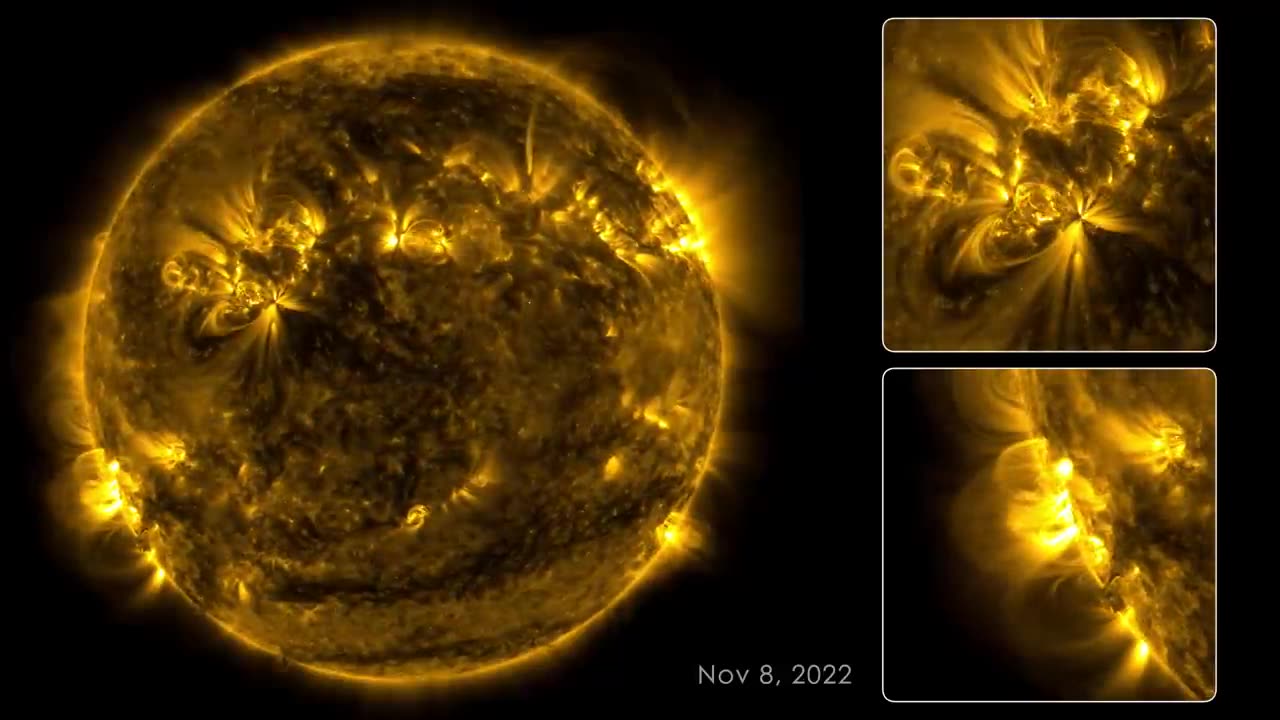Premium Only Content

133 Days on the Sun
This video chronicles solar activity from Aug. 12 to Dec. 22, 2022, as captured by NASA’s Solar Dynamics Observatory (SDO). From its orbit in space around Earth, SDO has steadily imaged the Sun in 4K x 4K resolution for nearly 13 years. This information has enabled countless new discoveries about the workings of our closest star and how it influences the solar system.
With a triad of instruments, SDO captures an image of the Sun every 0.75 seconds. The Atmospheric Imaging Assembly (AIA) instrument alone captures images every 12 seconds at 10 different wavelengths of light. This 133-day time lapse showcases photos taken at a wavelength of 17.1 nanometers, which is an extreme-ultraviolet wavelength that shows the Sun’s outermost atmospheric layer: the corona. Compiling images taken 108 seconds apart, the movie condenses 133 days, or about four months, of solar observations into 59 minutes. The video shows bright active regions passing across the face of the Sun as it rotates. The Sun rotates approximately once every 27 days. The loops extending above the bright regions are magnetic fields that have trapped hot, glowing plasma. These bright regions are also the source of solar flares, which appear as bright flashes as magnetic fields snap together in a process called magnetic reconnection.
While SDO has kept an unblinking eye pointed toward the Sun, there have been a few moments it missed. Some of the dark frames in the video are caused by Earth or the Moon eclipsing SDO as they pass between the spacecraft and the Sun. Other blackouts are caused by instrumentation being down or data errors. SDO transmits 1.4 terabytes of data to the ground every day. The images where the Sun is off-center were observed when SDO was calibrating its instruments.
SDO and other NASA missions will continue to watch our Sun in the years to come, providing further insights about our place in space and information to keep our astronauts and assets safe.
On the left side of the frame is the full circle of the Sun. It appears in a golden yellow color, but splotchy and with thin yellow wisps extending from the surface. Some areas are very bright and others almost black. The whole Sun rotates steadily, with one full rotation taking 12 minutes in this time lapse. There are usually only a few bright regions visible at a time and they shift and flash like small fires. From these regions there are wispy loops reaching up above the surface that rapidly change shape and size.
On the right side of the frame are two white-outlined squares with enlargements of interesting regions of the Sun.
-
 LIVE
LIVE
The Rubin Report
57 minutes agoListen to ‘The View’ Crowd Gasp as Whoopi Doubles Down on Extremist Rhetoric
21,813 watching -
 1:16
1:16
Steven Crowder
38 minutes agoI'm Back
68.1K303 -
 LIVE
LIVE
MattMorseTV
57 minutes ago🔴Trump's Oval Office DECLARATION.🔴
1,426 watching -
 LIVE
LIVE
Right Side Broadcasting Network
44 minutes agoLIVE: President Trump Makes an Announcement - 9/30/25
2,862 watching -
 LIVE
LIVE
LFA TV
12 hours agoBREAKING NEWS ALL DAY! | TUESDAY 9/30/25
3,446 watching -
 1:01:24
1:01:24
VINCE
2 hours agoDemocrats Can't Keep This Sex Criminal Locked Up | Episode 136 - 09/30/25
197K121 -
 LIVE
LIVE
Badlands Media
8 hours agoBadlands Daily: September 30, 2025
4,275 watching -
 LIVE
LIVE
The Big Mig™
2 hours agoPeace In The Middle East Or War?
4,651 watching -
 LIVE
LIVE
The State of Freedom
3 hours ago#337 What’s Behind the LA GOP Dysfunction? Insiders, Denialists & Deplorables
890 watching -
 1:42:59
1:42:59
Dear America
3 hours agoCharlie’s Killer Fights For NO DEATH PENALTY!! NOT HAPPENING!! + Gov Shutdown Imminent!!
138K84